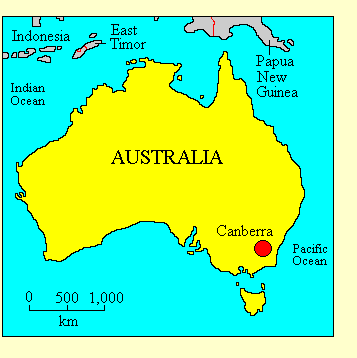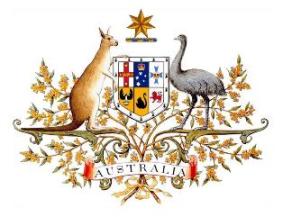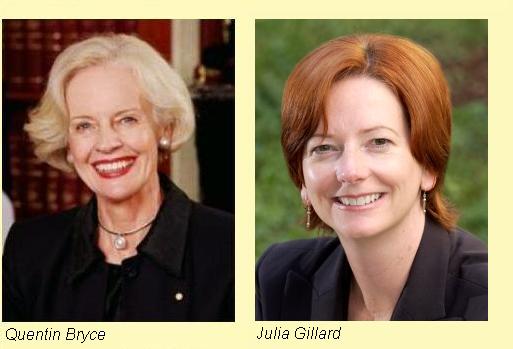

COMMONWEALTH OF AUSTRALIA
• Official name: Commonwealth of Australia
• Location: Pacific
• International organisations: Asia-Pacific Economic Co-operation Forum, Commonwealth of
Nations, Group of Twenty, Organisation
for Economic Co-operation and Development, Pacific Islands Forum, United Nations, World Trade Organisation
• Borders: None
• Coastline: Arafura Sea, Coral Sea, Indian Ocean, Tasman Sea, Timor Sea
• Land area: 7,686,850 Km2
• Population: 22,000,000
• Annual GDP (PPP) per capita: US$38,300 (2009 CIA estimate). World ranking: 17
• Ethnicity: Over 90% of Australians are of European descent, predominantly British but including migrants from
all European countries and their descendants. About 7% are of Asian descent, and about 2% are of
indigenous (Aboriginal or Torres Strait Islander) descent.
• Languages: English is the official language and is almost universally understood.
Many languages are spoken in the ethnic communities, the most common being Italian,
Greek, Arabic and Chinese. Aboriginal languages survive in remote areas.
• Religion: About 65% of the population are nominal Christians
(Catholic 26%, Anglican 19%, others 20%)
but Australia is one of the most secular countries in the world. There are growing
minorities of Moslems, Buddhists and Hindus and a small Jewish community.
• Form of government: Constitutional monarchy and federal parliamentary democracy.
Australia consists of six states, which retain their own parliaments and a wide area of
autonomy, and two federal territories, which have their own legislatures under
federal legislation.

• Capital: Canberra
• Constitution: The
Constitution of the Commonwealth of Australia came into effect on 1 January 1901,
and remains essentially unchanged.
• Head of state: Queen Elizabeth II, Queen of Australia. The Queen came to the
British throne on 6 February 1952, and has held the title Queen of Australia since
19 October 1973. The Queen's functions in Australia are exercised by a
Governor-General, appointed by the Queen on the advice of the Prime Minister.
Quentin Bryce took office as Governor-General on 5 September 2008.
• Head of government: The Prime Minister, appointed by the Governor-General. The Prime Minister is the leader of the largest
party in the legislature and is accountable to it.
• Legislature: Australia has a bicameral legislature, the Parliament of the
Commonwealth. It consists of the House of Representatives, which has 150 members
elected from single-member constituencies for three-year terms, and the Senate, which has 76
members elected by proportional representation from the states and territories for
six-year terms (three years in the case of Senators representing the territories).
• Electoral authority: The Australian Electoral
Commission administers federal elections.
• Freedom House 2011 rating: Political Rights 1, Civil Liberties 1
• Transparency International Corruption Index: 87% (8 of 178 countries rated)
• Reporters Without Borders Press Freedom 2010 Index: 94.6% (18 of 178 countries rated)
• Heritage Foundation Economic Freedom 2010 Index: 82.5% (3 of 178 countries rated)
Political history
British settlement of Australia began with the founding of Sydney as a penal colony
in 1788. During the early 19th century six British colonies were established around the
coasts. A gold rush in the 1850s greatly increased the population, and five of the six
colonies were given internal self-government before 1860 (Western Australia followed
in 1890). Australia pioneered such democratic ideas as the secret ballot, manhood
suffrage and votes for women.

In 1901 the six colonies federated to the form the Commonwealth of Australia
within the British Empire. The Australian Constitution was approved by the people at
referendum and can be amended in the same way. The Statute of Westminster in 1931 gave
Australia complete legislative independence from Britain. During World War II
Australia formed an allience with the United States which has been the basis of its
foreign policy ever since.
Massive postwar immigration from Europe, and more recently from Asia, has greatly
changed Australian society. In 1967 a referendum removed several references from the
Constitution which discriminated against the Aboriginal people, and Australia is now
officially a multicultural society. In 1999 a proposal to adopt a republican form of
government was rejected at a referendum.
Australia's oldest political party is the Australian Labor Party, a
moderate social democratic party based on trade union affiliates. Since
World War II, however, the most successful party has been the Liberal Party of Australia,
a free-market conservative party, which was in power from 1949 to 1972, 1975 to 1983,
and 1996 to 2007. It usually governs in coalition with the
National Party of Australia, a rural conservative
party. The Australian Greens won their first seat in the House of
Representatives at the 2010 election, and from July 2011 they will hold the balance of power in the Senate,
which is elected on a proportional basis.
At the 2007 federal election, the Liberal-National government of John Howard, who had
been Prime Minister for eleven years, was defeated by Labor under Kevin Rudd. In June 2010, after a
period of bad poll results, Labor deposed Rudd and replaced him with
Julia Gillard, Australia's first female
Prime Minister. At elections in August, Labor lost its majority in the House of Representatives, but
Gillard was able to form a minority government with the support of the Greens and three independents.
Updated October 2011
|


